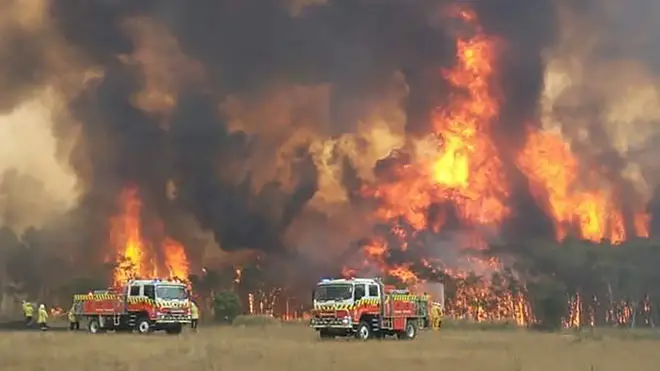
Ian Payne 4am - 7am
1 January 2020, 06:54

Australia has deployed military ships and aircraft to help communities ravaged by apocalyptic wildfires that destroyed homes and sent thousands fleeing to beaches for safety.
Royal Australian Navy ships and military aircraft were deployed to bring water, food and fuel to towns where supplies were depleted and roads were cut off by the fires.
As LBC News reported yesterday more than 4,000 people in the Victorian coastal town of Mallacoota fled to the shore as winds pushed a fire towards their homes under a sky darkened by smoke and turned red by flames.
Authorities had advised them to seek refuge in the sea if the blazes got too close, with hundreds of residents taking to boats and watercraft to flee the flames.
"Mallacoota is currently under attack," Victoria's state emergency commissioner Andrew Crisp said on Tuesday.
Stranded residents and holidaymakers slept in their cars, while petrol stations and surf clubs transformed into evacuation areas. Dozens of homes burned down before winds changed direction late Tuesday, sparing the rest of the town.
Victoria Emergency Commissioner Andrew Crisp told reporters the Australian Defence Force was moving naval assets to Mallacoota on a supply mission that would last two weeks. He said helicopters would fly in more firefighters, since roads were inaccessible.
Conditions cooled in most areas on Wednesday but the fire danger remained very high across the southern state, where four people are missing.
“We have three months of hot weather to come. We do have a dynamic and a dangerous fire situation across the state,” Mr Crisp said.
At 3am on 1 January 2020, there are 112 fires burning across NSW. Several large and dangerous fires continue burning on the South Coast where 2 fires remain at emergency warning. A further 6 fires are at Watch and Act. Over 2500 firefighters continue working on these fires.
In the NSW town of Conjola Park, 50 properties were destroyed and cars were partially melted by Tuesday’s fires.
More than 100 fires were still burning in the state on Wednesday, though none were at an emergency level.
Four people have died this week, a volunteer firefighter, a man found in a burnt-out car and a father and son who died in their house. Their deaths bring the total to 13 since Australia’s severe wildfire season began in September.
NSW Premier Gladys Berejiklian said firefighting crews would take advantage of easing conditions on Wednesday to restore power to critical infrastructure and conduct back-burning.
The early and devastating start to Australia’s summer wildfires has led authorities to rate this season the worst on record.
It has also reignited debate about whether Prime Minister Scott Morrison’s conservative government has taken enough action on climate change.
Army Blackhawks have arrived in East Gippsland. First task transporting fresh firefighters into Mallacoota and returning with vulnerable patients experiencing respiratory and other issues. #TYFYS #lovegippsland @CDF_Aust @DeptDefence @ScottMorrisonMP @DVACommissioner pic.twitter.com/UKRzEVxAB2
— Darren Chester MP (@DarrenChesterMP) January 1, 2020
Australia is the world’s largest exporter of coal and liquefied natural gas. Mr Morrison rejected calls last month to downsize Australia’s lucrative coal industry.
Mr Morrison won a surprise third term for the conservatives in May. Among his government’s pledges was to reduce greenhouse gas emissions by 26-28% by 2030 — a modest figure compared to the centre-left opposition Labor party’s pledge of 45%.
The leader of the minor Australian Greens party, Richard Di Natale, demanded a royal commission, the nation’s highest form of inquiry, on the wildfire crisis.
“If he (Mr Morrison) refuses to do so, we will be moving for a parliamentary commission of inquiry with royal commission-like powers as soon as parliament returns,” Di Natale said in a statement.
Some 12.35 million acres of land – an area almost as big as Croatia – have burned nationwide over the past few months, with more than 1,000 homes destroyed.
HMAS Choules and MV Sycamore have sailed from Sydney, on their way to provide support to bushfire relief efforts on NSW South Coast and NE Victoria. Navy also continues to provide helicopters and support to @NSWRFS aerial operations.#AustralianNavy #AustraliaFires #OurCommunity pic.twitter.com/PHWp8L0Tvy
— Chief of Navy Australia (@CN_Australia) January 1, 2020
Some communities cancelled New Year’s fireworks celebrations, but Sydney’s popular display over its iconic harbour controversially went ahead in front of more than a million revellers. The city was granted an exemption to a total fireworks ban in place there and elsewhere to prevent new wildfires.
Smoke from the wildfires meant Canberra, the nation’s capital, on Wednesday had air quality more than 21 times the hazardous rating to be reportedly the worst in the world.
The smoke has also wafted across the Tasman Sea and into New Zealand.